

Sea Turtle Conservancy. Each year thousands of hatchling turtles emerge from their nests along the southeast U.S. coast and enter the Atlantic Ocean.

Sadly, only an estimated one in 1,000 to 10,000 will survive to adulthood. The natural obstacles faced by young and adult sea turtles are staggering, but it is the increasing threats caused by humans that are driving them to extinction. Today, all sea turtles found in U.S. waters are federally listed as endangered, except for the loggerhead which is listed as threatened. USFWS File Photo Natural Threats In nature, sea turtles face a host of life and death obstacles to their survival. Human-Caused Threats Harvest for Consumption Photo by Rauli Virtanen Although sea turtles have spiritual or mythological importance in many cultures around the world, this has not prevented humans from consuming their eggs or meat.
Illegal Sea Turtle Shell Trade Sea Turtle Conservancy File Photo Commercial Fishing: Longline & Trawl Photo by Salvador Garcia Loggerhead escaping through a TED. Illegal Poaching — SEE Turtles. Despite laws protecting sea turtles in most countries, the illegal trade of eggs, meat, and shells (known as poaching) of turtles continues to be a threat.
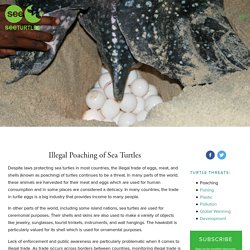
In many parts of the world, these animals are harvested for their meat and eggs which are used for human consumption and in some places are considered a delicacy. In many countries, the trade in turtle eggs is a big industry that provides income to many people. Light Pollution Deters Nesting Sea Turtles. Light pollution along the Mediterranean is changing the nesting habits of sea turtles in Israel, according to new research.
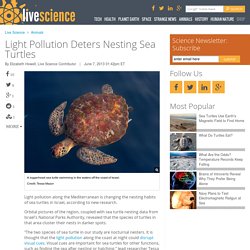
Orbital pictures of the region, coupled with sea turtle nesting data from Israel's National Parks Authority, revealed that the species of turtles in that area cluster their nests in darker spots. "The two species of sea turtle in our study are nocturnal nesters. It is thought that the light pollution along the coast at night could disrupt visual cues. Millions of sea turtles trapped by fishing nets. A global data review shows that during the past 20 years millions of sea turtles have been inadvertently snared by methods used in commercial fishing.
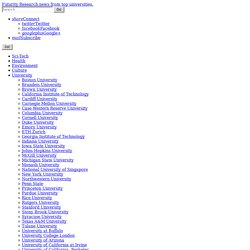
Effective measures to reduce turtle bycatch include the use of circle hooks and fish bait in longline fisheries, and Turtle Excluder Devices in trawling. Many of the most effective types of gear modifications have been developed by fishermen themselves. View more photos. (Credit: Goncalo Veiga/Wikimedia Commons) DUKE (US)—The number of sea turtles inadvertently snared by commercial fishing gear over the past 20 years may reach into the millions, according to the first peer-reviewed study to compile sea turtle bycatch data from gillnet, trawl, and longline fisheries worldwide.
The study, which was published in the journal Conservation Letters, analyzed data compiled from peer-reviewed papers, government reports, technical reports, and symposia proceedings published between 1990 and 2008. More Duke University news: www.dukenews.duke.edu/ Sea Turtle Threats - Threats from Commercial Fishing. The Problem: Each year, sea turtles are accidentally captured, injured or killed by fishermen.
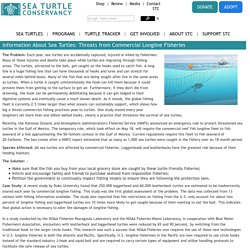
Many of these injuries and deaths take place while turtles are migrating through fishing areas. The turtles, attracted to the bait, get caught on the hooks used to catch fish. A long line is a huge fishing line that can have thousands of hooks and lures and can stretch for several miles behind boats. Many of the fish that are being sought after live in the same areas as turtles. When a turtle is caught unintentionally the hook can kill them because it could prevent them from getting to the surface to get air. MTN 121:1-5 Trade Secrets: A Ten Year Overview of the Illegal Import of Sea Turtle Products into the United States. Seaturtle.org : MTN : ARCHIVES : INDEX : Sign In Marine Turtle Newsletter 121:1-5, © 2008 Trade Secrets: A Ten Year Overview of the Illegal Import of Sea Turtle Products into the United States Susan M.
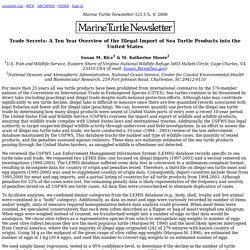
Rice1 & M. Katherine Moore21U.S. For more than 25 years all sea turtle products have been prohibited from international commerce by the 170-member nations of the Convention on International Trade in Endangered Species (CITES). We reviewed the USFWS Law Enforcement Management Information System (LEMIS) database records specific to sea turtle take and trade. To facilitate analyses, we combined similar categories from the LEMIS database (e.g., body, shell, trophy and live animal were combined in a “body” category). KidRex - Kid Safe Search Engine.
The survival of the sea turtle - Scott Gass. Discover what makes a sea turtle so wonderfully adapted for the marine environment, gain a greater appreciation for the challenges they face, follow efforts to rescue and protect sea turtles both domestically and internationally, and uncover what you can do to help celebrate and preserve these amazing marine animals as you explore Saving a Species: Sea Turtles.
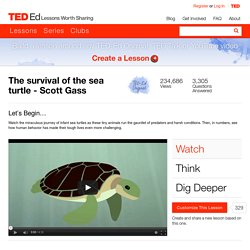
Looking for a rich source of sea turtle information? Look no further than SeaWorld’s Sea Turtle InfoBook! Covering topics such as adaptations for a marine environment, habitat and distribution, diet and feeding habits, conservation issues, and more, this resource will prove a useful and interesting tool. (And if you’re looking for even more, there are a variety of topic-related classroom resources also available on the site.)